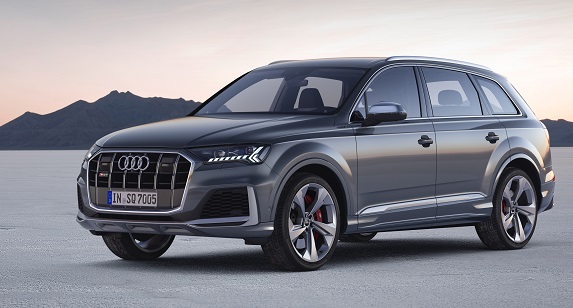

SUV, 5 Doors, 44747 Seats
7.4-7.6 l/100 km 31.79 - 30.95 US mpg
8.4-8.6 l/100 km 28 - 27.35 US mpg
6.8-7.0 l/100 km 34.59 - 33.6 US mpg
435 Hp @ 3750-4750 rpm.
110 Hp/l
250 km/h 155.34 mph
3956 cm3
241.41 cu. in.
8, V-engine
All wheel drive (4x4),
5066 mm
199.45 in.
1970 mm
77.56 in.
2320-2385 kg
5114.72 - 5258.02 lbs.
| Brand | Audi |
|---|---|
| Model | SQ7 (SUV) |
| Version | SQ7 (facelift 2019) |
| Engine version | 4.0 TDI V8 (435 Hp) quattro Tiptronic |
| Year production start | 2019 |
| Year production end | 2020 |
| Vehicle type | SUV |
| Horsepower RPM | 435 Hp @ 3750-4750 rpm. |
| Acceleration 0 - 100 kmh sec | 4.8 sec |
| Curb weight kg -lbs total |
2320-2385 kg5114.72 - 5258.02 lbs. |
| Overall length mm - inch |
5066 mm199.45 in. |
| Doors | 5 |
| Top Speed | 250 km/h 155.34 mph |
| Designation model | DMVA |
|---|---|
| Engine position and orientation | Front, Longitudinal |
| Cylinders | 8 |
| Position of cylinders | V-engine |
| Displacement (liters) |
3956 cm3241.41 cu. in. |
| Eng. horsepower RPM | 435 Hp @ 3750-4750 rpm. |
| Horsepower per litre | 110 Hp/l |
| Weight / horsepower kg/hp - hp/tons |
5.3 kg/Hp187.5 Hp/tonne |
| Weight / torque kg/Nm - Nm/tons | 2.6 kg/Nm, 387.9 Nm/tonne
2.6 kg/Nm387.9 Nm/tonne |
| Torque Nm RPM lb-ft RPM |
900 Nm @ 1250-3250 rpm.663.81 lb.-ft. @ 1250-3250 rpm. |
| Bore (mm in) |
83 mm3.27 in. |
| Stroke (mm in) |
91.4 mm3.6 in. |
| Compression ratio | 16 |
| Fuel delivery system | Diesel Commonrail |
| Fuel type | Diesel |
| Valvetrain | 4 |
| Engine aspiration | Twin-Turbo / e-Turbocharger, Intercooler |
| Engine oil liters | quarts |
8.8 l9.3 US qt | 7.74 UK qt |
| Engine coolant |
14.9 l15.74 US qt | 13.11 UK qt |
| Emission certification | Euro 6 DG |
| Powertrain architecture | Internal Combustion engine |
| Engine location | Front, Longitudinal |
| Drive configuration | All wheel drive (4x4) |
|---|
| Front brakes | Ventilated discs, 400 mm |
|---|---|
| Rear brakes | Ventilated discs, 400 mm |
| Brake control | Ventilated discs, 370 mm |
| Anti-lock brake system | ABS (Anti-lock braking system) |
| Steering type | Steering rack and pinion |
|---|---|
| Turning diameter m - ft |
12.5 m41.01 ft. |
| Front suspension | Independent multi-link |
|---|---|
| Rear suspension | Multi-link independent |
| Wheels size | 285/45 R20 112Y |
|---|---|
| Wheels rims | 9.0J x 20 |
| Passengers seats | 44747 |
|---|---|
| Trunk space max liter | cu. Ft. |
1957-1975 l69.11 - 69.75 cu. ft. |
| Roof load load kg lbs |
100 kg220.46 lbs. |
| Overall length mm - inch |
5066 mm199.45 in. |
|---|---|
| Overall width mm -inch |
1970 mm77.56 in. |
| Overall height mm -inch |
1743 mm68.62 in. |
| Wheelbase mm - inch |
2996 mm117.95 in. |
| Track width front mm - inch |
1663 mm65.47 in. |
| Track width rear mm - inch |
1663 mm65.47 in. |
| Coefficient of drag | 0.33 |
| Curb weight kg -lbs total |
2320-2385 kg5114.72 - 5258.02 lbs. |
|---|---|
| Gross weight kg -lbs total |
3050-3155 kg6724.1 - 6955.58 lbs. |
| Capacities kg - lbs |
730-770 kg1609.37 - 1697.56 lbs. |
| Fuel tank liters | gallons |
85 l22.45 US gal | 18.7 UK gal |
| City l/100km - mpg |
8.4-8.6 l/100 km28 - 27.35 US mpg |
|---|---|
| Highway l/100 km - mpg |
6.8-7.0 l/100 km34.59 - 33.6 US mpg |
| Combined l/100 km - Mpg |
7.4-7.6 l/100 km31.79 - 30.95 US mpg |
| Autonomy km (combined use) | 1149 |
| Combined fuel consumption (WLTP) | 9.1-9.7 l/100 km 25.85 - 24.25 US mpg |
8 CYLINDER V-Engine
https://www.thecarspec.net/components/engine/8-cylinders-v